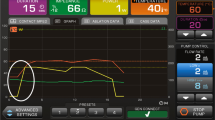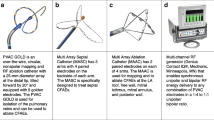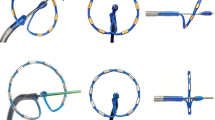Abstract
Background and purpose
Saline-irrigated radiofrequency ablation (RFA) for atrial fibrillation (AF) is limited by the absence of reliable thermal feedback limiting the utility of temperature monitoring for power titration. The DiamondTemp (DT) ablation catheter was designed to allow efficient temperature-controlled irrigated ablation. We sought to assess the 1-year clinical safety and efficacy of the DT catheter in treating drug-refractory paroxysmal AF.
Methods
The TRAC-AF trial (NCT02821351) is a prospective, multi-center (n = 4), single-arm study which enrolled patients with symptomatic, drug-refractory, paroxysmal AF. Using the DT catheter, point-by-point ablation was performed around all pulmonary veins (PVs) to achieve PV isolation (PVI). Ablation was performed in a temperature-controlled mode (60 °C, max 50 W). Acute and chronic efficacy and safety was evaluated.
Results
Seventy-one patients (age 69.9 ± 11.0 years; 60.6% male) were ablated using the DT catheter. The mean fluoroscopy and RF ablation times were 9.3 ± 6.1 min and 20.6 ± 8.9 min, respectively. Acute isolation of all PVs was achieved in 100% of patients, and freedom from AF after 1 year was 70.6%. There were no steam pops, char, or coagulum on the catheter tip after ablation. There were few serious procedure/device-related adverse events including a single case of cardiac tamponade (1.4%) and transient ischemic attack (1.4).
Conclusion
This first in man series demonstrates that temperature-controlled irrigated RFA with the DT catheter is efficient, safe, and effective in the treatment of paroxysmal AF. Randomized controlled trials are ongoing and will evaluate better the role of this catheter in relation to standard RFA.
Trial registration
Registered on the site ClinicalTrials.gov January 2016 with identifier: NCT02821351



Similar content being viewed by others
Availability of data and materials
Data are available for review.
Code availability
Not applicable
References
Feinberg WM, Blackshear JL, Laupacis A, Kronmal R, Hart RG. Prevalence, age distribution, and gender of patients with atrial fibrillation. Analysis and implications. Arch Intern Med. 1995;155:469–73.
Go AS, Hylek EM, Phillips KA, Chang Y, Henault LE, Selby JV, et al. Prevalence of diagnosed atrial fibrillation in adults: national implications for rhythm management and stroke prevention: the AnTicoagulation and Risk Factors in Atrial Fibrillation (ATRIA) Study. JAMA. 2001;285:2370–5.
Krahn AD, Manfreda J, Tate RB, Mathewson FA, Cuddy TE. The natural history of atrial fibrillation: incidence, risk factors, and prognosis in the Manitoba follow-up study. Am J Med. 1995;98:476–84.
Calkins H, Kuck KH, Cappato R, Brugada J, Camm AJ, Chen SA, et al. 2012 HRS/EHRA/ECAS expert consensus statement on catheter and surgical ablation of atrial fibrillation: recommendations for patient selection, procedural techniques, patient management and follow-up, definitions, endpoints, and research trial design. J Interv Card Electrophysiol. 2012;33:171–257.
Haïssaguerre M, Jaïs P, Shah DC, Takahashi A, Hocini M, Quiniou G, et al. Spontaneous initiation of atrial fibrillation by ectopic beats originating in the pulmonary veins. N Engl J Med. 1998;339:659–66.
Haïssaguerre M, Jaïs P, Shah DC, Gencel L, Pradeau V, Garrigues S, et al. Right and left atrial radiofrequency catheter therapy of paroxysmal atrial fibrillation. J Cardiovasc Electrophysiol. 1996;7:1132–44.
Nademanee K, McKenzie J, Kosar E, Schwab M, Sunsaneewitayakul B, Vasavakul T, et al. A new approach for catheter ablation of atrial fibrillation: mapping of the electrophysiologic substrate. J Am Coll Cardiol. 2004;43:2044–53.
Luik A, Kunzmann K, Hörmann P, Schmidt K, Radzewitz A, Bramlage P, et al. Cryoballoon vs. open irrigated radiofrequency ablation for paroxysmal atrial fibrillation: long-term FreezeAF outcomes. BMC Cardiovasc Disord. 2017;17:135.
Kuck KH, Reddy VY, Schmidt B, Natale A, Neuzil P, Saoudi N, et al. A novel radiofrequency ablation catheter using contact force sensing: Toccata study. Heart Rhythm. 2012;9:18–23.
Starek Z, Lehar F, Jez J, Wolf J, Kulik T, Zbankova A, et al. Periprocedural 3D imaging of the left atrium and esophagus: comparison of different protocols of 3D rotational angiography of the left atrium and esophagus in group of 547 consecutive patients undergoing catheter ablation of the complex atrial arrhythmias. Int J Cardiovasc Imaging. 2016;32:1011–9.
Stárek Z, Lehar F, Jež J, Wolf J, Novák M. 3D X-ray imaging methods in support catheter ablations of cardiac arrhythmias. Int J Cardiovasc Imaging. 2014;30:1207–23.
Neuzil P, Reddy VY, Kautzner J, Petru J, Wichterle D, Shah D, et al. Electrical reconnection after pulmonary vein isolation is contingent on contact force during initial treatment: results from the EFFICAS I study. Circ Arrhythm Electrophysiol. 2013;6:327–33.
Kuck KH, Hoffmann BA, Ernst S, Wegscheider K, Treszl A, Metzner A, et al. Gap-AF–AFNET 1. Impact of complete versus incomplete circumferential lines around the pulmonary veins during catheter ablation of paroxysmal atrial fibrillation: results from the gap-atrial fibrillation-german atrial fibrillation competence network 1 trial. Circ Arrhythm Electrophysiol. 2016;9:e003337.
Afzal MR, Chatta J, Samanta A, Waheed S, Mahmoudi M, Vukas R, et al. Use of contact force sensing technology during radiofrequency ablation reduces recurrence of atrial fibrillation: a systematic review and meta-analysis. Heart Rhythm. 2015;12:1990–6.
Iwasawa J, Koruth JS, Petru J, Dujka L, Kralovec S, Mzourkova K, et al. Temperature-controlled radiofrequency ablation for pulmonary vein isolation in patients with atrial fibrillation. J Am Coll Cardiol. 2017;70:542–53.
Reddy VY, Dukkipati SR, Neuzil P, Natale A, Albenque JP, Kautzner J, et al. Randomized, controlled trial of the safety and effectiveness of a contact force-sensing irrigated catheter for ablation of paroxysmal atrial fibrillation: results of the TactiCath contact force ablation catheter study for atrial fibrillation (TOCCASTAR) Study. Circulation. 2015;132:907–15.
Dukkipati SR, Cuoco P, Kutinsky I, Aryana A, Bahnson TD, Lakkireddy D, et al. Pulmonary vein isolation using the visually guided laser balloon: a prospective, multicenter, and randomized comparison to standard radiofrequency ablation. J Am Coll Cardiol. 2015;66:1350–60.
Kuck KH, Brugada J, Fürnkranz A, Metzner A, Ouyang F, Chun KR, et al. Cryoballoon or radiofrequency ablation for paroxysmal atrial fibrillation. N Engl J Med. 2016;374:2235–45.
Voskoboinik A, Kalman ES, Savicky Y, Sparks PB, Morton JB, Lee G, et al. Reduction in radiation dose for atrial fibrillation ablation over time: A 12-year single-center experience of 2344 patients. Heart Rhythm. 2017;14:810–6.
Cappato R, Calkins H, Chen SA, Davies W, Iesaka Y, Kalman J, et al. Updated worldwide survey on the methods, efficacy, and safety of catheter ablation for human atrial fibrillation. Circ Arrhythm Electrophysiol. 2010;3:32–8.
Funding
This work was supported by Advanced Cardiac Therapeutics, Santa Clara, California, USA. Dr. Neuzil have received research grant support from Advanced Cardiac Therapeutics, Inc. Dr. Reddy has served as a consultant to and has received research grant support from Advanced Cardiac Therapeutics, Inc. All other authors have reported that they have no relationships relevant to the contents of this paper to disclose.
Author information
Authors and Affiliations
Corresponding author
Ethics declarations
Ethics approval
The study was approved by the institutional review boards at each of the 4 clinical sites.
Consent to participate
All participants enrolled in this study provided informed consent.
Consent for publication
All authors agree with the publication of this manuscript.
Additional information
Publisher’s note
Springer Nature remains neutral with regard to jurisdictional claims in published maps and institutional affiliations.
Rights and permissions
About this article
Cite this article
Starek, Z., Lehar, F., Jez, J. et al. Efficacy and safety of novel temperature-controlled radiofrequency ablation system during pulmonary vein isolation in patients with paroxysmal atrial fibrillation: TRAC-AF study. J Interv Card Electrophysiol 64, 375–381 (2022). https://doi.org/10.1007/s10840-021-00986-0
Received:
Accepted:
Published:
Issue Date:
DOI: https://doi.org/10.1007/s10840-021-00986-0




